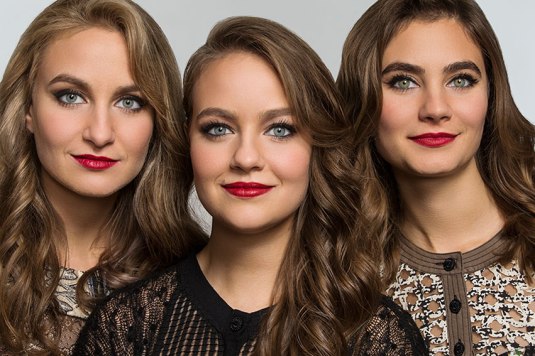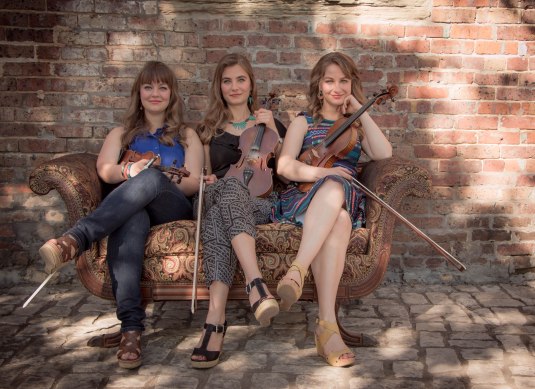
When the Quebe Sisters from Texas take a stage, and the triple-threat fiddle champions start playing and singing in multi-part close harmony, audiences are usually transfixed, then blown away. It’s because the group plays their own unique blend of Western swing, hot jazz and Texas fiddle tunes with extreme authority, energy and talent. And whether the Quebes are decked out in denims and boots or fashionably dressed to the nines, the three sisters, all in their 20s, look as good as they sound!
The Quebe Sisters will perform on Sunday, May 1st at 7:30 PM at the Unitarian Universalist Congregation of York, 925 S. George Street in York. The concert is sponsored by the Susquehanna Folk Music Society. The Quebe Sisters will be joined on stage by Simon Stipp on guitar and Daniel Parr on bass.
Concert tickets are $25 General Admission, $22 for SFMS members and $10 for students ages 3-22. Advance tickets are available online HERE, or toll-free (800) 838-3006.
For more information, visit the Susquehanna Folk Music Society website.
The interview below with Hulda Quebe was conducted by Brandon Merritt and originally published on February 18, 2016.
______________________________________________________
BRANDON: Tell us a little about the start of the Quebe Sisters, and what brought you to where you are today.
HULDA: – You know, my sisters and I first heard fiddling at a contest. And we had never heard fiddling before. And it was just like a whole new world opened up to us. My mom had always really like the violin as an instrument. So, we had kind of taken some classical lessons, and we actually quit for the summer. We weren’t that serious into it, and when we heard fiddling, it was just kind of a light bulb going on. And then I thought, “Well that looks really fun, you know, we could try that”. I remember our mom called and asked about taking some lessons with these teachers. We just started taking lessons and it was just kind of something that happened, where we started taking lessons and fiddling and I guess you could tell that we progressed pretty quickly. We started competing in contests, and that’s kind of how we got started playing music.
After we had been playing awhile individually in these contests, we all took lessons together. So, we would all kind of sit in the same room, and we also all played at the same level since we had all started together. And so it was just kind of a natural progression I think for us to work up tunes together. We were listening to a lot of different styles of music at that point, other than just fiddling, Texas-style fiddling, and things like that. So, when our teacher said, “Do you all want to work up a tune together?” it was just kind of a natural progression and just went from there.

BRANDON: What (or who) has had some of the greatest influence on your music?
HULDA: Well, definitely the Texas-style fiddle players were the first people who influenced us. Benny Thomasson, and I would say Terry Morris. Other fiddle players that you might be more familiar with, Johnny Gimble, who passed away, and we’ve got the guys who were session players, they really influenced out playing. Then we started playing country and western swing. The jazz fiddle players, we listened to a lot of that. And we also listened to a lot of western music growing up. Then we went through the other styles of music. We listened to jazz, and we listened to a lot of bluegrass too. I remember the first bluegrass band that I ever heard, that I really sat down and listened to steady was a group called Hot Rize, and they’re still going today, they’re actually awesome.
I remember vocally we had been listening to the Mills Brothers before we started singing. So, the Mills Brothers I think are to this day my favorite vocal group as far as just perfection wise. We also listened to the McGuire Sisters a lot, and we listened to the Andrews Sisters some. The biggest vocalists that I can think of that really influenced our singing were Merle Haggard, Connie Smith, and Ella Fitzgerald, all the classical singers that you can think of, we listened to everybody.
BRANDON We can see that you’ve had a lot of different influences on your music, yet you have a very unique style. How do you bring all of that together and make your sound?
HULDA: A lot of it, when we were a lot younger, our teacher was kind of crafting our arrangements and things, and we were all kind of listening to music and learning, and we would be like “Oh, we listened to…” and we would work up some tunes from that, or listen to that and see what we could learn from it. For us I think, as you can see, we listened to a lot of different types of music, and of course then we also delved into swing music and jazz. I could list all the artists from the swing era and even a few today that influence us.
Picking songs, picking arrangements – we look at our set list, we look at whether you need a slower one or a faster one, what have you been listening to, does the song hit you. We just listen to a lot of different types of things and then just kind of go, well, how does everyone feel about this song? Do you love it? And then wait for everyone else. “Have you heard this?” And most the time, we all have. That’s kind of how we go about picking our material. And also we’ll find a song that will fit our band and the vision that we have for the music, and how we want to grow to the next step.
We’re also working on original stuff. But, we haven’t put that into the set just yet, but hopefully it will be coming up real soon, so we’re really excited about that. [Editor’s note-this interview was a few months ago. I believe this has changed since then.]

BRANDON: You’ve put out three albums, the latest being Every Which-A-Way. What are some of your favorite things about putting that album together?
HULDA: I think that one of the things I really love about that album is that the vision we had going in was to record it as naturally as possible. The three of us got in one room, we got three mics, we set it up, and we recorded all of our parts live, vocals and our fiddles. That was our goal, to create something that was very natural, and that would also stand out compared to other records, and still have the same precision and quality. That’s something I’m really, I guess you could say, proud of about that album. It’s the way that we recorded it. A lot of the song selections were tunes that a lot of people had requested. A lot of our favorite arrangements and tunes we wanted to get down and record them.
BRANDON: Music is ever-changing, and all musicians and bands want to see a progression as time goes on. What are some the changes that you have seen as a group over the years?
HULDA: That’s a good question, it’s a hard question to answer. I think for us some of it is performance wise, growing our audience, getting your name out there, and going and traveling and seeing people enjoy your music, that they like it and what you’re doing and what you put your life into. You know, that’s come to fruition and people like it and enjoy it. You can actually be a professional full-time touring band and make a living off of it, and it’s really rewarding.

For us I think musically since we started out not really intending to be a band, there were a lot of things. I remember one day it was kind of like a blink and we were playing the Grand Ole Opry, and it was just very surreal. I never really considered myself, “Well, I’m a professional fiddle player at age thirteen”, because one I wasn’t, but two I was looking at music and learning and growing. When we were younger we got to do some really cool stuff – play for the President, play for Asleep At The Wheel. I remember Ricky Skaggs brought us out to the Grand Ole Opry in 2003. And there were a lot of things that happened like that. We feel really blessed that they happened. It was really crazy to think I never even dreamed…I never even really considered that this would be a dream of mine. When I played the Opry, I didn’t even know that I could dream to do that! It’s really been fun for us growing and becoming better musicians. It’s something that’s not always obvious to an audience, but there’s nights when you can tell the band just got tighter, or that was a way better show, or you had a breakthrough musically where you figured something out and had little victories.
For us vocally, we took some vocal lessons. I remember learning new information because your voice is so different than playing another instrument. It changed our lives, I remember that was a huge moment for us.
BRANDON: As the band pours itself into creating and playing music, what is it that you want listeners to take away from it, be it at a live show or a recording that they hear?
HULDA: One, I want them to take away from it that it’s good music. I truly believe that whatever you do, do it to the best of your ability. And if you’re playing music it’s just like any other art, you really want your art and your craft to be excellent. That’s one.
But I think the biggest thing for me is that people go away with it having an emotional response. They feel the sad songs, and the happy songs really truly bring them joy. And when we play live, I think one of my things is the reaction. Just last night I looked out at the audience and this lady, you I could just tell that there was a huge smile on her face and she was just grinning from ear to ear, she was having so much fun. And I thought, “That’s what makes everything we do worth while”. If you can bring someone else joy and bring a smile to their face, that’s the whole point of putting on a performance I think, to make people feel things that they wouldn’t otherwise. Having someone come up to you at the end of the show and say, “I’ve had a terrible week, I almost didn’t come tonight, but I’m so glad I did because you made me forget just how bad my week was and I just enjoyed myself so much”, that’s why we do what we do.
_______________________________________________________
This interview was published on the blog “Merritt’s Mandolin Minute”. Brandon started this blog out of a love for bluegrass music, and a desire to preserve and pass it on to others. This interview was used with permission. You can view its original publication HERE.



